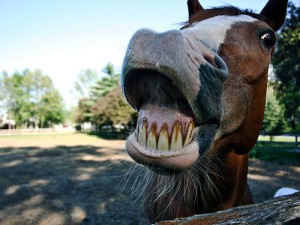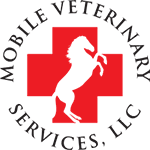 In recent years, veterinarians have started to recognize a fairly common syndrome that can happen to horses over 15 years of age. In these horses, the conformation of the incisor and canine teeth (the teeth in the front of the mouth used to pull grass off the pasture, or to bite the unwary owner!) can begin to change and eventually lead to a condition called Equine Odontoclastic Tooth Resorption and Hypercementosis or EOTRH.
In recent years, veterinarians have started to recognize a fairly common syndrome that can happen to horses over 15 years of age. In these horses, the conformation of the incisor and canine teeth (the teeth in the front of the mouth used to pull grass off the pasture, or to bite the unwary owner!) can begin to change and eventually lead to a condition called Equine Odontoclastic Tooth Resorption and Hypercementosis or EOTRH.
These changes can happen over years and are more commonly seen in horses over the age of 20, but have been diagnosed in horses as young as 15 years old. For reasons that are not yet well understood by the equine veterinary community, these teeth begin to resorb (or dissolve) at the roots and in the bone around the roots. As this process progresses, these teeth become more likely to become infected with bacteria and the amount of baseline pain and discomfort that the horse feels becomes quite significant, leading to changes in eating habits, weight loss, and even personality and attitude changes.
These older horses usually have a very high pain tolerance at this age, and since the process is one that occurs over months to years, it can take some time before owners actually realize that they are seeing some of these changes. We usually encounter this during a normal dental examination of an older horse, often times due to reported weight loss. Frequently, this weight loss also coincides with not wanting to eat hay, or slowing down on how they eat hay, or even refusing horse cookies, carrots or apples due to the pain that is caused when these things are bitten with the incisors. These horses are definitely in need of help and treatment.
What Can We Do?
Although it sounds dramatic, the best thing to do for these horses is to extract all of the affected teeth. This can be anywhere from 2 incisors on the corners, to all 12 incisor teeth. Sometimes this is done in stages (the worst teeth first) and sometimes it is done all at once. Depending on the severity of the changes on radiographs (X-rays), your vet will make the decision on how many teeth need to be removed.
Surprisingly, once the diseased teeth are extracted, all of these horses almost immediately begin to eat normally again and put on weight. Many of them start to feel so much better that owners report the behavior of the horse changing and beginning to be “spunky” again! In one case, an owner who had rescued an older, “quiet” horse realized that the calmness was due to the pain from this disease, and that the horse they had adopted was actually QUITE energetic and high strung after the cause of the pain and disease was removed! So far, all of the patients that we have seen for incisor extraction have also had dramatic weight gain in the months following the resolution of this procedure. Suddenly, a skinny old horse was found to be a fairly “easy keeper”.
So, if your older horse is showing any of the above signs, or if their incisors are starting to look like the gums are receding, or inflamed, have your vet check them for visible signs of EOTRH, and maybe even perform some dental X-rays to check and see if having extractions performed are in the best interest for your horse.
For more information on EOTRH, we’ve included some very good links below.
Here you’ll find some great photos and radiographs on this posting from Midwest Equine Services
http://www.midwestequineservices.com/eotrh_syndrome.cfm
About midway down on this page, there’s some great information from Cornell Veterinary School
http://www.vet.cornell.edu/hospital/Services/Equine/Dentistry/procedures.cfm
This a great case report from CSU’s stellar dental veterinarian, Dr. Jennifer Rawlinson and includes photos




